You can rarely go wrong with a Jeff Mariotte Buffyverse novel, but some go more right than others, and “Stranger to the Sun” (July 2002) isn’t one of his elite efforts. His second book set in “Angel’s” second season is quite readable, but it’s pretty obvious where every plot thread is going right from the beginning. On the other hand, it’s a decent character piece for Wesley – even though he’s asleep most of the time.
As the story begins, Wesley is hit with sleeping powder, which we eventually learn has been dispatched by L.A. vampire kingpin MacKenna to take out anyone who looks at the stars for a living, from astronomers to astrologists to those familiar with the supernatural. Thus “Stranger to the Sun” branches into two tales: Wesley’s dream adventure and the gang’s attempts to find a way to wake him (and similarly addled citizens) up.
MacKenna’s scheme is to use a ritual to tilt the Earth so that one side is permanently dark, and therefore a vampire paradise. This calls to mind the Season 4 plot where the sun gets magically covered up in L.A. As the “Angel” and “Buffy” TV series wore on, magic and the supernatural eventually became so ubiquitous that the public knew about it – and that became the status quo in the comics that continued the narrative.
“Stranger to the Sun” is set in Season 2, though, so Mariotte felt it was important to explain how the Earth could shift on its axis for a bit, then be corrected by a counter-ritual by the forces of good, and yet it would never be referenced again in the Buffyverse narrative — thus the sleeping-powder attacks on stargazers.
Unfortunately, that makes this whole thing goofier. For one, there’s no way MacKenna could knock out every good magic-user and stargazer on the planet. For another, why bother with non-magic-using stargazers? The fact that they notice the Earth shifting won’t allow them to stop it. And for another, if the Earth really did shift on its axis, everyone would notice; it would be obvious in so many easy-to-observe ways, such as catastrophic weather and geologic events.
Mariotte tries valiantly to build up Gunn’s gang of vampire hunters, but as with the TV series, they don’t stay in my memory as distinct individuals. They are moderately but steadily ticked off at Gunn for spending time with Angel Investigations. They feel snubbed, which is understandable, and they also loathe Angel for being a vampire, which is less understandable since Gunn has explained to them that Angel is a good guy and Angel has proven it many times.
There’s not much to say about Angel in this book; he’s just doing his detective thing, and being a little bit bland and cold toward Gunn. He’s all business here.
Cordelia’s soft-heartedness is on fine display as she worries over Wesley and also exchanges emails with one of Wes’ supernatural-expert contacts, who devises a solution to the sleeping powder and the Earth’s tilt – but then is never heard from again in the Buffyverse. His name is Franklin Ayers Bishop; I figure I should mention his name since he’s pretty much the most ingenious and powerful spur-of-the-moment magic-user in the whole saga. (By contrast, MacKenna has been planning this scheme for decades.)
Wesley has a vivid 10-hour dream about being trapped in a coal mine with his fellow miners. Mariotte does a nice job of illustrating how Wes’ memories of his actual life in L.A. is just out of his mental grasp. As soon as it’s noted that Wes has a great-grandfather who was a miner, and who survived a cave-in, it’s clear that Wesley is in with that group. I learned a lot about the perils of mining, at least.
Mariotte also delivers a darkly amusing thread about a raver girl who rejects a guy because he’s boring – and who later becomes a ritual sacrifice with the more interesting guy she hooks up with. But for all the author’s good writing, “Stranger from the Sun” suffers from being too predictable and chronicling a particularly silly evil scheme.
Click here for an index of all of John’s “Buffy” and “Angel” reviews.


